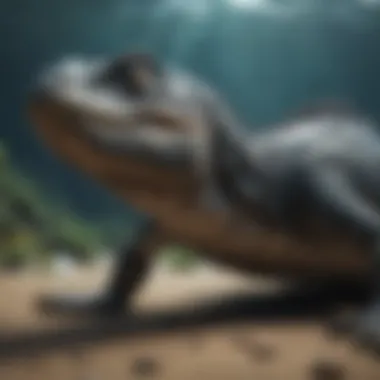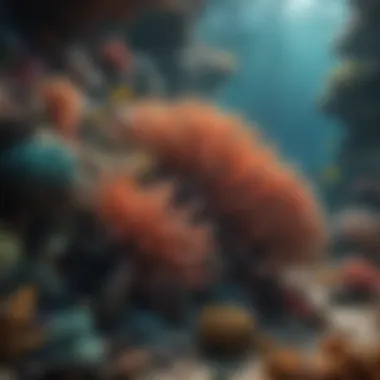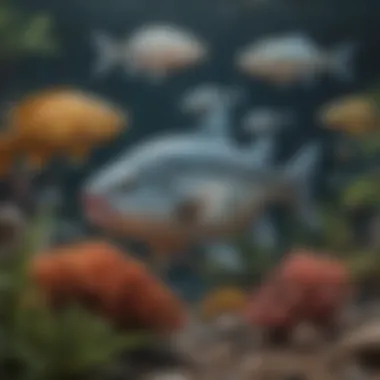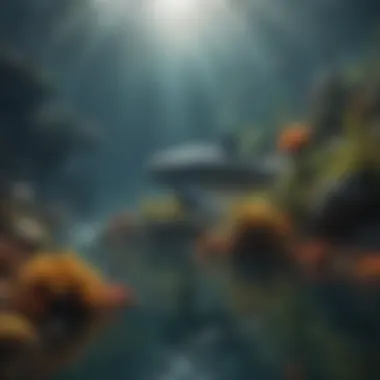Exploring Extinct Ocean Animals and Their Legacy


Intro
Understanding ocean ecosystems requires an exploration of not just existing species, but also those that once thrived in our seas. The waters have been home to a multitude of unique creatures that no longer exist. This article aims to delve into the depths of the marine past, focusing on the complex lives of extinct ocean animals. By investigating their ecological importance, how they perished, and the implications of their extinction, we can learn about the fragile balance that sustains modern marine life.
Examining extinct species offers insight into the evolutionary pathways of life in the ocean. The story of these creatures tells us a great deal about the past environment and poses questions relevant to today's conservation efforts. Each extinct species plays a role in understanding marine biodiversity and the drastic changes that have occurred over millions of years.
Prologue to Extinction in Marine Environments
Understanding extinction in marine environments is crucial in acknowledging the complex interplay between oceanic life and environmental changes over time. This section will serve as a foundation for exploring the extinction of marine animals.
Defining Extinction
Extinction refers to the end of an organism or a group of organisms, resulting in the absence of its kind from a particular habitat or globally. It can happen gradually or abruptly due to various factors. In the marine context, extinction can occur at the species level, meaning that no living individuals exist, or at higher taxonomic levels, referring to groups of related species. This process is a natural part of the evolutionary framework, yet the rate at which species disappear today raises concerns regarding the stability of marine ecosystems.
Although extinction is a normal phenomenon driven by factors such as natural disasters or environmental shifts, human-induced pressures have significantly accelerated the extinction rate in recent centuries. This change primarily stems from overfishing, habitat destruction, pollution, and climate change.
Historical Context of Marine Extinction
The history of marine extinction is extensive and reflective of shifting environmental conditions. Events such as the Permian mass extinction approximately 252 million years ago resulted in the loss of nearly 95% of marine species. Such events were often catalyzed by significant geological and climatic transitions, including volcanic eruptions and ice ages.
In the more recent past, during the Holocene epoch, human activities have led to notable extinction events. The Steller's Sea Cow, once thriving in the North Pacific, was hunted to extinction within 27 years of its discovery in the 18th century. This instance illustrates the profound impact humans can have on marine populations, exacerbating natural extinction processes.
Extinctions throughout history show a pattern where diverse ecosystems, once disrupted, take long periods to recover, if at all. Understanding these contexts allows wildlife biologists and conservationists to devise strategies that promote the preservation of existing marine biodiversity.
"Understanding the past is essential in addressing the challenges of the present and future regarding marine life conservation."
By examining history and defining extinction in marine environments, we set the stage for a detailed exploration of notable extinct ocean animals and their roles in the ecosystem.
A Brief Overview of Notable Extinct Ocean Animals
Understanding notable extinct ocean animals provides insight into the historical diversity and complexity of marine ecosystems. These creatures, now vanished, once played crucial roles in their environments. By examining their lives, we glean lessons about biodiversity and conservation, relevant to our ongoing struggles with current ocean crises. Each animal discussed reveals a unique story about adaptation, survival, and ultimately, demise to inform about our own time.
Megalodon
Megalodon, scientifically known as Carcharocles megalodon, represents one of the largest predators to have ever roamed the seas. This enormous shark flourished around 23 to 3.6 million years ago, measuring up to 60 feet long. Its massive size and powerful jaws allow it to prey on large marine mammals, such as whales. Fossils of Megalodon teeth indicate it had a serrated edge designed for tearing flesh. The absence of such gigantic predators today highlights significant shifts in marine ecosystems throughout history.
The extinction of Megalodon is attributed to several factors, including changing ocean temperatures and the decline of its prey. As environments changed, Megalodon struggled to adapt, leading to its eventual disappearance around the end of the Pleistocene epoch. Its extinction serves as a poignant reminder of the fragility of marine life and ecosystem balance.
Steller's Sea Cow
Steller's Sea Cow, a remarkable marine herbivore, once inhabited the cold waters of the North Pacific. Discovered by explorers in the 18th century, this gentle giant grew up to 30 feet long and relied on underwater vegetation. Unfortunately, its slow movement and lack of fear of humans contributed to its rapid extinction. Within thirty years of its discovery, overhunting led to the demise of this species.
The loss of Steller's Sea Cow had ripple effects on its ecosystem, particularly the kelp forests it fed on. Without this large herbivore, kelp populations surged, affecting other species dependent on these habitats. The story of Steller's Sea Cow illustrates the interconnectedness of marine ecosystems and the importance of protecting even the seemingly less significant species.
Dodo Fish (Coryphaena hippurus)


Most know the Dodo as a flightless bird from Mauritius, but it is also used in the context of the Dodo Fish known as Coryphaena hippurus, which commonly goes by mahi-mahi. Unlike its namesake, the Dodo Fish is not extinct but serves as a reminder of marine biodiversity. Its vibrant colors and swift nature make it a popular fish among fishermen and chefs alike.
The significance of the Dodo Fish lies in its role in ecosystems and cultures. It provides sustenance and contributes to local economies. Moreover, understanding the overfishing trends affecting species like the Dodo Fish can help guide conservation practices. Learning from both extinct and extant species is vital to ensure sustainable fishing and protect marine biodiversity.
In summary, examining notable extinct ocean animals, including Megalodon, Steller's Sea Cow, and understanding the concepts associated with the Dodo Fish, highlights the intricate web of life in the ocean. These narratives shape our comprehension of marine environments and emphasize the urgency of conservation efforts.
The Ecosystem Roles of Extinct Marine Species
The extinction of marine species is not just a loss of biodiversity; it reflects profound changes in ocean ecosystems. Each extinct species played a role that contributed to the structure and function of these environments. Understanding the ecosystem roles of extinct marine animals is essential for appreciating their impact on both ancient and current marine life. As these species disappeared, the delicate balance of the ocean's food webs transformed. This section explores the critical roles that extinct marine species once fulfilled, focusing on predatory dynamics and prey relationships.
Predatory Dynamics
Predators are significant in any ecosystem. They control prey populations and help maintain a healthy balance within the food web. Extinct marine predators, such as the megalodon, illustrated this perfectly. As one of the largest predatory sharks, megalodon influenced the health of fish populations during its time. Its hunting habits likely regulated the numbers of marine mammals and large fish, creating a dynamic that was essential for ocean health.
With the loss of apex predators like megalodon, the populations of smaller prey species can grow uncontrollably. This population boom can lead to overgrazing of algae and other marine plants, potentially instigating widespread ecosystem collapse. Such cascading effects illustrate how critical predator roles are in maintaining marine biodiversity.
Prey Relationships
The interplay between prey species and their predators creates a rich tapestry of life in the ocean. Extinct marine species, such as Steller's sea cow, provide insights into these relationships. This herbivorous mammal played a crucial role in controlling plant populations in coastal regions. As it grazed on kelp forests, it promoted the growth of other marine plants, maintaining the ecosystem's diversity. Without such organisms, kelp forests can become overrun, leading to habitat degradation and loss for numerous marine species.
The extinction of prey species can lead to significant shifts in marine ecosystems. This results in a change of predator-prey dynamics that can ripple through the entire system. For example, the deletion of smaller fish species can impact larger predators due to food shortages, leading to their decline. Thus, the extinction of prey species disrupts balance and can accelerate the overall degradation of marine environments.
Understanding the roles of extinct marine species is essential to comprehend the current and future state of marine ecosystems.
Causes of Extinction: Historical and Environmental Factors
Understanding the causes of extinction in marine environments is crucial for several reasons. First, it sheds light on the historical patterns that have shaped current ocean ecosystems. By analyzing these factors, we can identify which species are most at risk today and why. Furthermore, it highlights how interactions between living organisms and their environment have evolved over time. This section examines key elements contributing to marine extinction, focusing on climate change, human impact, and natural catastrophes.
Climate Change
Climate change significantly influences marine ecosystems. It alters sea temperatures, affects ocean currents, and leads to sea level rise. Warmer waters can cause coral bleaching and disrupt breeding patterns for many aquatic species. For instance, species like the Atlantic cod have seen declines due to changing temperature ranges, impacting their migration and spawning. The resulting shifts in habitat can lead to mass extinctions if species cannot adapt quickly enough to the new conditions. As documented in various studies, changes in pH levels from ocean acidification further threaten marine life by affecting the calcium carbonate structures that some species depend on for survival.
Human Impact on Ocean Ecosystems
Human activities are a major driver of extinction. Overfishing, pollution, and habitat loss from coastal development are among the most pressing threats to marine species. The bluefin tuna, for example, has experienced drastic population declines due to relentless fishing practices. Pollution, including plastics, has infiltrated the ocean, harming wildlife through ingestion or entanglement. Moreover, habitat degradation, such as the destruction of mangroves and coral reefs, directly impacts the marine biodiversity that relies on these ecosystems for shelter and breeding. Understanding human actions and their consequences is essential for protecting marine life and preventing future extinctions.
Natural Catastrophes
Natural disasters, while occurring less frequently than human impact, also play a role in extinction events. Events such as volcanic eruptions, tsunamis, and asteroid impacts have historically led to massive biodiversity loss. The Cretaceous-Paleogene extinction event, which eradicated the non-avian dinosaurs alongside numerous marine species, serves as a prime example. Such catastrophes can drastically change environmental conditions and decimate populations that cannot adapt in time.
Understanding these natural forces, while they may seem uncontrollable, helps scientists create models predicting future extinctions under similar circumstances. Recognizing the interplay of various causes of extinction—whether ecological, anthropogenic, or natural—can guide current conservation efforts and inspire proactive measures to sustain marine biodiversity.
"The health of ocean ecosystems is intricately linked to the survival of countless marine species. Understanding the causes of extinction provides the groundwork for effective conservation strategies."
The analysis of these historical and environmental factors is vital. By comprehending the complex interactions at play, we can better inform conservation policies, aiming to protect what remains of our ocean biodiversity today.


Impacts of Extinction on Modern Marine Biodiversity
The extinction of marine animals has profound implications for modern marine biodiversity. It marks a significant reduction in the variety of life forms present in ocean habitats. When a species disappears, it does not just vanish from the food chain; it alters the delicate balance of ecologies. This section delves into the consequences of lost diversity, where each aspect merits attention.
Biodiversity Loss
Biodiversity is essential for healthy ecosystems. Different species contribute unique functions that maintain ecological balance. Extinction diminishes this variety, leading to a loss of genetic diversity. For example, when large predatory animals like the Megalodon went extinct, potential shifts occurred in prey populations. The unchecked proliferation of smaller species can lead to overcrowding, resulting in resource depletion.
The loss of biodiversity also limits the resilience of ecosystems. A diverse range of species can better withstand environmental changes. In contrast, ecosystems dominated by a few species may experience collapse faster during disturbances.
"Biodiversity acts as a buffer against environmental changes. When diversity wanes, so does the system's ability to cope with stressors."
Thus, maintaining species variety is essential not only for the present but also for future adaptability.
Potential for Ecosystem Collapse
With the decline in species richness, the risk of ecosystem collapse increases. Each species plays a specific role; the removal of even a single one can initiate a chain reaction. Functions like pollination, nutrient cycling, and habitat creation can be compromised.
Consider the Steller's Sea Cow, a herbivore that had an important role in maintaining kelp forests. Its extinction led to overgrowth of these underwater plants, which, in turn, affected other marine species that depended on open water and light. As species become interdependent, the potential for a systemic collapse grows.
The potential for collapses becomes even greater in face of climate change and pollution, which already stress marine environments. The combination of extinction and these modern challenges creates a precarious situation for marine biodiversity. The lessons learned from extinct species underline the urgency for concerted conservation efforts.
Paleontological Evidence of Extinct Marine Animals
Paleontological evidence is crucial for reconstructing the history of marine life on Earth. This field not only provides insight into the varieties of extinct marine species but also highlights the intricate connections between past and present marine ecosystems. Fossils bear witness to evolutionary trends and biodiversity fluctuations over geological time scales. Understanding this evidence allows scientists and conservationists to make educated decisions regarding marine biodiversity management today.
Fossil Records
Fossil records serve as the primary source of data concerning extinct marine animals. These records include not just bones or shells but also ichnofossils, which reflect the activities or behaviors of these ancient organisms. Each fossil layer provides a snapshot of a particular time period, detailing which species thrived, which were in decline, and how they interacted with their environment.
The sedimentary nature of ocean floors means that many marine fossils are well-preserved and can be dated accurately. This dating is often accomplished through radiometric methods, which enable scientists to assign specific ages to pertinent strata. Understanding the context in which fossils are found enhances our knowledge of marine extinction events. For instance, mass extinctions, such as the Cretaceous-Paleogene boundary, can be explored through fossil data. Significant shifts in fossil diversity often align with these drastic ecological changes, marking important transitional phases in marine history.
Technological Advances in Marine Paleontology
Recent advances in technology have transformed the field of marine paleontology. With the introduction of methods such as CT scanning and 3D modeling, researchers can study fossils in unprecedented detail without damaging the specimens. These techniques allow for thorough examination of internal structures and anatomical features.
Molecular paleontology is another frontier that reveals details about ancient marine species at a cellular level. By analyzing ancient DNA, scientists can infer evolutionary relationships and gain insights into the genetic makeup of long-gone ocean inhabitants. Furthermore, improved imaging techniques have enabled the visualization of soft tissues from fossils, providing a more complete representation of species than ever before.
In summary, understanding paleontological evidence is necessary for grasping the scale of marine extinctions and their implications for contemporary biodiversity. Through fossil records and technological advancements, we gain both a historical perspective and tools that could guide current conservation efforts.
"Fossils are the final testaments of extinct marine animals, revealing the story of life on our planet one layer at a time."
Case Studies of Extinct Ocean Animals
Case studies of extinct ocean animals provide valuable insights into the consequences of biodiversity loss. These individual stories highlight how specific species interacted within their ecosystems. Understanding these relationships helps appreciate the ecological complexities of marine environments. Moreover, these case studies can inform modern conservation efforts and demonstrate the need to protect existing aquatic life.


The Woolly Mammoth: A Plesiosaur Connection
The Woolly Mammoth is often viewed through a terrestrial lens. However, its connection to marine environments can be intriguing. Fossil evidence suggests that Woolly Mammoths inhabited areas near coastal regions. They likely relied on marine ecosystems for sustenance. The Plesiosaur, on the other hand, was a marine reptile that existed millions of years earlier. It thrived in ocean waters, showing how diverse marine life can vary through evolution. Studying these creatures sheds light on ecological relationships across different environments. It also raises questions about how ancient marine dynamics can inform our understanding of current oceanic ecosystems.
The Influence of the Dodo
The Dodo's impact extends far beyond its native habitat on Mauritius. Though not a marine animal, its extinction serves as a crucial lesson about how human activity can disrupt ecosystems. The bird's demise also triggered changes in local marine habitats. With the Dodo gone, the seeds that it once dispersed decreased in abundance. This had a cascading effect on both terrestrial and marine life. The lessons learned from the Dodo's story emphasize the importance of maintaining biodiversity. Protecting marine species often requires recognizing interconnected relationships across different ecosystems. As humans continue to engage with ocean environments, the Dodo's legacy prompts reflection on conservation efforts for marine species.
Conservation Lessons from Extinct Marine Species
Understanding the extinction of marine species offers significant insights into contemporary conservation efforts. When we study who has vanished from ocean ecosystems, it allows us to identify patterns and unseen challenges faced by modern species. Learning from the past helps formulate effective and targeted strategies for preservation and restoration of marine biodiversity. This section focuses on how insights drawn from extinct species can guide current conservation initiatives to prevent further losses in ocean ecosystems.
Modern Conservation Efforts
Today, conservationists apply lessons learned from extinct marine species to current practices. These efforts include:
- Protection of Habitats: Recognizing that the loss of habitat leads to species decline, initiatives now focus on safeguarding critical ecosystems, such as coral reefs and estuaries, from pollution, human activities, and climate change.
- Restoration Projects: Successful restoration of ecosystems like the Chesapeake Bay can be guided by understanding past ecosystems that thrived. By examining what contributed to successes and failures in similar projects, conservationists can design better revival plans.
- Public Education and Awareness: By showcasing the stories of marine animals that have vanished, conservation groups aim to instill a sense of urgency and responsibility regarding ocean health in the public. Educational campaigns illustrate the interdependence of species and ecosystems.
- Policy Development: Scientific evidence highlights the direct correlations between human actions and extinction rates. Policy-makers now use this data to create regulations that limit overfishing, pollution, and urban development along coastlines, which can lead to more sustainable practices.
The Importance of Protecting Existing Biodiversity
Protecting existing biodiversity is imperative for the health of our oceans. Extinct species serve as stark reminders of what can happen when ecosystems are disturbed. Here are some key reasons that stress the importance of preservation:
- Ecosystem Functionality: Every species plays a role within its ecosystem. Losing one, even at a seemingly low level of hierarchy, can trigger a domino effect. For instance, if predator species decline, it may lead to unchecked prey populations, which can degrade the habitat.
- Genetic Diversity: The diversity within marine genetics is crucial for resilience against disease and environmental shifts. Loss of species equates to loss of genetic resources that might play a key role in adaptability and survival of other marine species.
- Human Dependency: Many communities depend on marine life for sustenance and economic activities, such as fishing and tourism. The loss of biodiversity threatens food security, livelihoods, and cultural practices.
- Future Discoveries: Continuing to protect existing marine species might reveal potential medicinal properties or ecological benefits that humankind has yet to discover. Each extinct species represents a lost opportunity for nature to provide solutions to various challenges we face today.
"In losing species, we not only lose the diversity of life but also the delicate balance that supports our oceans and, ultimately, us."
Closure: Reflecting on Extinction and Future Prospects
The subject of extinction, particularly in marine ecosystems, urges us to evaluate the intertwined relationship between species and their habitats. This reflection is not merely academic; it carries significant implications for contemporary conservation practices. The history of marine extinction reveals how human activities, climate fluctuations, and ecological interconnectivity can lead to irreversible loss. These historical precedents stress the urgent necessity for a proactive approach in conservation.
Understanding the consequences of past extinctions illuminates the paths forward for current marine conservation efforts. By recognizing the patterns and triggers of extinction, conservationists can develop more informed strategies that can potentially safeguard endangered species today. Drawing lessons from past failures and successes informs policy-making and can foster more resilient ocean ecosystems. Thus, the significance of this topic offers multifaceted benefits not only for scientists but also for policymakers and the public.
The Ongoing Challenge of Marine Conservation
Marine conservation faces numerous hurdles in the modern era. With the growth of global populations and economies, oceanic habitats continue to experience escalating pressures. Pollution, overfishing, and climate change profoundly impact marine life and biodiversity. Conservation initiatives must adapt to increasingly complex scenarios where human interests often clash with ecological needs.
Some ongoing challenges include:
- Marine Pollution: Contaminants ranging from plastics to chemical run-off severely affect aquatic ecosystems.
- Climate Change: Rising temperatures and ocean acidification present unprecedented challenges for marine species and habitats.
- Overfishing: Unsustainable fishing practices have led to drastic declines in certain fish populations, disrupting food chains.
More than just recovery efforts, marine conservation calls for a holistic understanding of marine ecosystems. Collaborative efforts involving governments, non-governmental organizations, and communities play a critical role in promoting sustainable practices.
"Conservation begins with an understanding of ecosystems and their intricate balances. Only through education can we hope to protect what remains."
Final Thoughts on Extinction
Reflecting on extinction is not merely a retrospective endeavor; it is intrinsically tied to restoring and preserving marine biodiversity. Awareness and education about extinct species can spark interest in conservation. The stories of these animals often resonate, giving context to the fragility of existing species.
While maintaining a focus on urgent conservation needs, it is just as vital to instill a sense of hope. Modern technologies and scientific advancements provide new opportunities for restoration efforts and ecological monitoring. There exists a potential to not only prevent extinctions but also to restore some past habitats through innovative methods such as aquaculture and genetic technologies.
Recognizing our shared responsibility is critical. Extinction is a reality, but it need not be an inevitability for current marine species. Each extinction narrative can serve as a call to action, motivating scientists, policymakers, and the general public to engage with ocean conservation proactively. In doing so, we might steer away from the fate of those that have existed before us.







